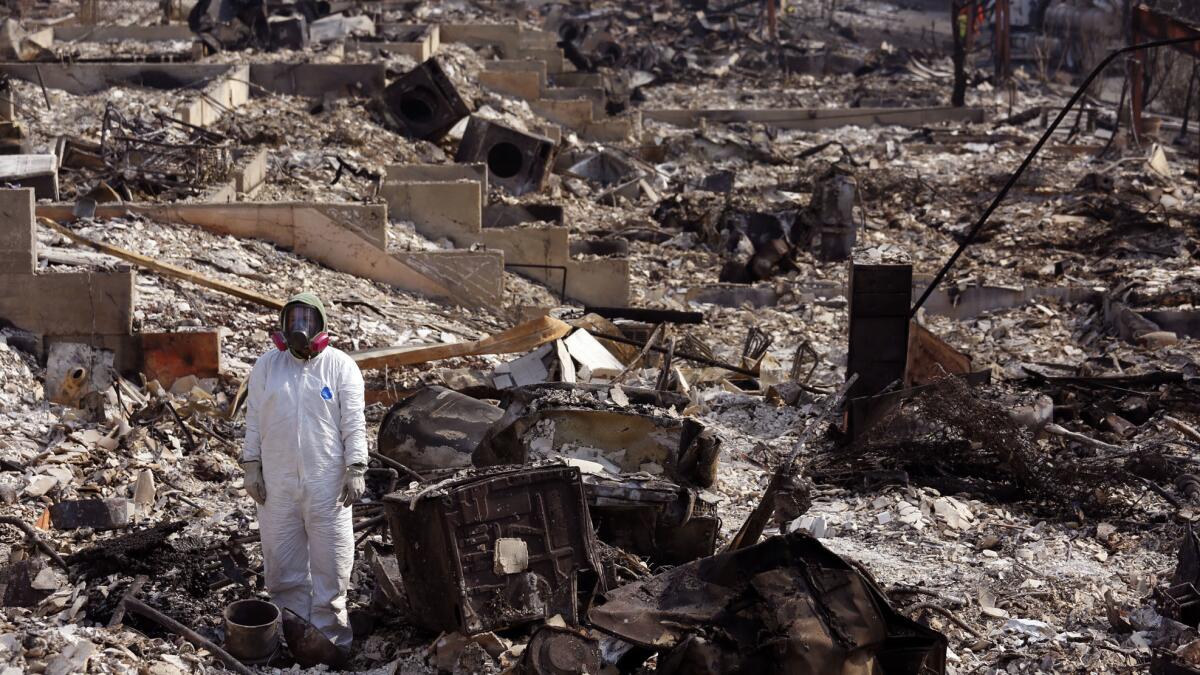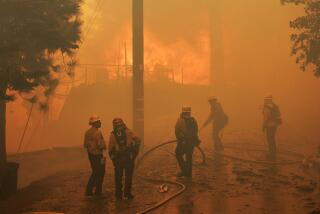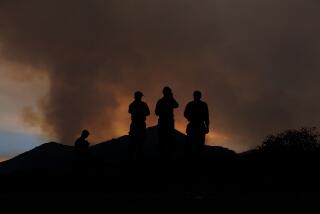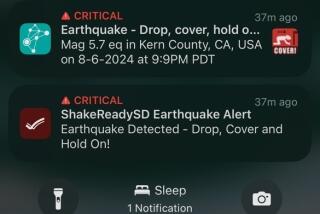Lack of emergency alerts during firestorms prompts calls for improvements

Reporting from Santa Rosa, Calif. â Widespread complaints that residents did not receive cellphone alerts before wildfires swept through Californiaâs wine country, destroying thousands of homes and killing more than 40 people, has prompted calls to improve the system.
The so-called Wireless Emergency Alert system allows authorities to push out warnings that trigger loud alarms and vibrations to cellphones in geographic areas, unless people specifically opt out.
But neither Sonoma County nor Napa County sent them.
Now, as the North Bay reels from the devastation, Californiaâs two U.S. senators have raised questions about deficiencies in the federal system after many wine country residents failed to get warnings that they were in the path of last weekâs destructive wildfires.
Because of the systemâs imprecise geo-targeting capabilities, the Democratic senators wrote, authorities have to decide whether to notify too many people â or not nearly enough â when disaster strikes.
In a letter dated Tuesday to the chairman of the Federal Communications Commission, Sens. Kamala Harris and Dianne Feinstein said authorities instead relied on alert systems that were far less effective.
âThese emergency services are caught in a bind between notifying individuals in imminent danger and risking mass panic,â the senators wrote. âAs a result, these services are compelled to rely on emergency messaging systems with far less reach and far less capacity.â
The senators wrote they were disappointed that the FCC had not fully implemented a 2016 proposal to require wireless carriers to enable more precise geo-targeting for emergency alerts.
âWe are also concerned that the FCC has granted a temporary waiver of the existing, imprecise geo-targeting requirements for certain carriers,â they wrote.
The senators asked FCC Chairman Ajit Pai to get feedback from officials in Northern California, as well as those who responded to Hurricanes Harvey, Irma and Jose, about how the warning system should be improved.
When the fires erupted, some residents had minutes to escape. Neighbors pounded on one anotherâs doors and blasted car horns. Friends called friends and urged them to get out.
Some couldnât outrun the flames.
Meanwhile, Sonoma County officials contemplated sending out a mass alert. Ultimately, they decided not to out of concern it would have pinged every cellphone connected to a cell tower in Sonoma County.
They worried about unnecessary gridlock on streets far from the fire and impeding first-responders trying to reach threatened areas.
Instead, the county sent out warnings through its SoCoAlert service and Nixle, both of which require residents to register before an emergency. The county also sent out reverse 911 calls to landlines in unincorporated areas.
Santa Rosa, where rows of suburban tract homes were destroyed, sent out alerts through SoCoAlert, Nixle and on social media.
Napa County issued alerts through Nixle, but officials said some residents had trouble receiving the warnings.
By Tuesday, the string of wildfires raging for more than a week had scorched more than 210,000 acres and destroyed whole neighborhoods.
Dozens of people are still missing.
Fire crews have, however, turned a corner in battling the blazes, reaching more than 50% containment on the four largest wildfires. Tens of thousands of residents were allowed to return home and at least one hospital reopened.
The 52,894-acre Nuns fire, which gave firefighters the most trouble over the weekend, was 78% contained.
A smaller, stubborn fire that ignited Saturday near the Oakmont neighborhood on the eastern edge of Santa Rosa burned 1,029 acres and was 27% contained as of Tuesday evening.
Officials told firefighters to be meticulous about extinguishing smoldering piles of grasses and leaves because higher winds expected later Tuesday could send embers into unburned areas, igniting new fires.
âMop-upâs going to be the key. As we get to the point where the perimeterâs controlled, all the stuff inside needs to be controlled, 100%,â said Don Watt, a fire behavior analyst for the state Department of Forestry and Fire Protection.
The biggest danger to firefighters over the next few days is fatigue, which has set in after eight long, smoky days of firefighting, officials told crews in Sonoma on Tuesday morning.
âYou guys have been in warp drive,â said Bret Gouvea, the Cal Fire incident commander. âNow the adrenaline is coming off. Youâre feeling the fatigue. Youâre getting tired. Letâs finish this thing strong, without any major accidents.â
Willon reported from Santa Rosa, Serna from Calistoga,Tchekmedyian from Los Angeles. Laura J. Nelson in Santa Rosa and Rong-Gong Lin II in Los Angeles contributed to this report.
UPDATES:
9 p.m.: This article has been updated throughout additional quotes and background information.
This article was originally published at 7:25 p.m.
More to Read
Sign up for Essential California
The most important California stories and recommendations in your inbox every morning.
You may occasionally receive promotional content from the Los Angeles Times.













